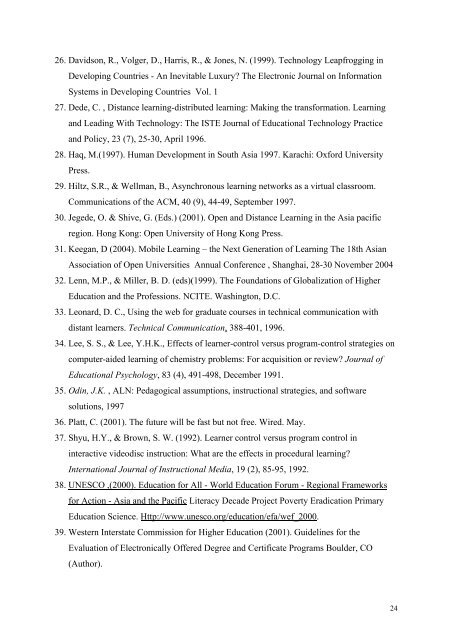Open and Distance Learning: Transitioning to an E-learning ...
Open and Distance Learning: Transitioning to an E-learning ...
Open and Distance Learning: Transitioning to an E-learning ...
You also want an ePaper? Increase the reach of your titles
YUMPU automatically turns print PDFs into web optimized ePapers that Google loves.
26. Davidson, R., Volger, D., Harris, R., & Jones, N. (1999). Technology Leapfrogging in<br />
Developing Countries - An Inevitable Luxury? The Electronic Journal on Information<br />
Systems in Developing Countries Vol. 1<br />
27. Dede, C. , <strong>Dist<strong>an</strong>ce</strong> <strong>learning</strong>-distributed <strong>learning</strong>: Making the tr<strong>an</strong>sformation. <strong>Learning</strong><br />
<strong><strong>an</strong>d</strong> Leading With Technology: The ISTE Journal of Educational Technology Practice<br />
<strong><strong>an</strong>d</strong> Policy, 23 (7), 25-30, April 1996.<br />
28. Haq, M.(1997). Hum<strong>an</strong> Development in South Asia 1997. Karachi: Oxford University<br />
Press.<br />
29. Hiltz, S.R., & Wellm<strong>an</strong>, B., Asynchronous <strong>learning</strong> networks as a virtual classroom.<br />
Communications of the ACM, 40 (9), 44-49, September 1997.<br />
30. Jegede, O. & Shive, G. (Eds.) (2001). <strong>Open</strong> <strong><strong>an</strong>d</strong> <strong>Dist<strong>an</strong>ce</strong> <strong>Learning</strong> in the Asia pacific<br />
region. Hong Kong: <strong>Open</strong> University of Hong Kong Press.<br />
31. Keeg<strong>an</strong>, D (2004). Mobile <strong>Learning</strong> – the Next Generation of <strong>Learning</strong> The 18th Asi<strong>an</strong><br />
Association of <strong>Open</strong> Universities Annual Conference , Sh<strong>an</strong>ghai, 28-30 November 2004<br />
32. Lenn, M.P., & Miller, B. D. (eds)(1999). The Foundations of Globalization of Higher<br />
Education <strong><strong>an</strong>d</strong> the Professions. NCITE. Washing<strong>to</strong>n, D.C.<br />
33. Leonard, D. C., Using the web for graduate courses in technical communication with<br />
dist<strong>an</strong>t learners. Technical Communication, 388-401, 1996.<br />
34. Lee, S. S., & Lee, Y.H.K., Effects of learner-control versus program-control strategies on<br />
computer-aided <strong>learning</strong> of chemistry problems: For acquisition or review? Journal of<br />
Educational Psychology, 83 (4), 491-498, December 1991.<br />
35. Odin, J.K. , ALN: Pedagogical assumptions, instructional strategies, <strong><strong>an</strong>d</strong> software<br />
solutions, 1997<br />
36. Platt, C. (2001). The future will be fast but not free. Wired. May.<br />
37. Shyu, H.Y., & Brown, S. W. (1992). Learner control versus program control in<br />
interactive videodisc instruction: What are the effects in procedural <strong>learning</strong>?<br />
International Journal of Instructional Media, 19 (2), 85-95, 1992.<br />
38. UNESCO ,(2000). Education for All - World Education Forum - Regional Frameworks<br />
for Action - Asia <strong><strong>an</strong>d</strong> the Pacific Literacy Decade Project Poverty Eradication Primary<br />
Education Science. Http://www.unesco.org/education/efa/wef_2000.<br />
39. Western Interstate Commission for Higher Education (2001). Guidelines for the<br />
Evaluation of Electronically Offered Degree <strong><strong>an</strong>d</strong> Certificate Programs Boulder, CO<br />
(Author).<br />
24
















